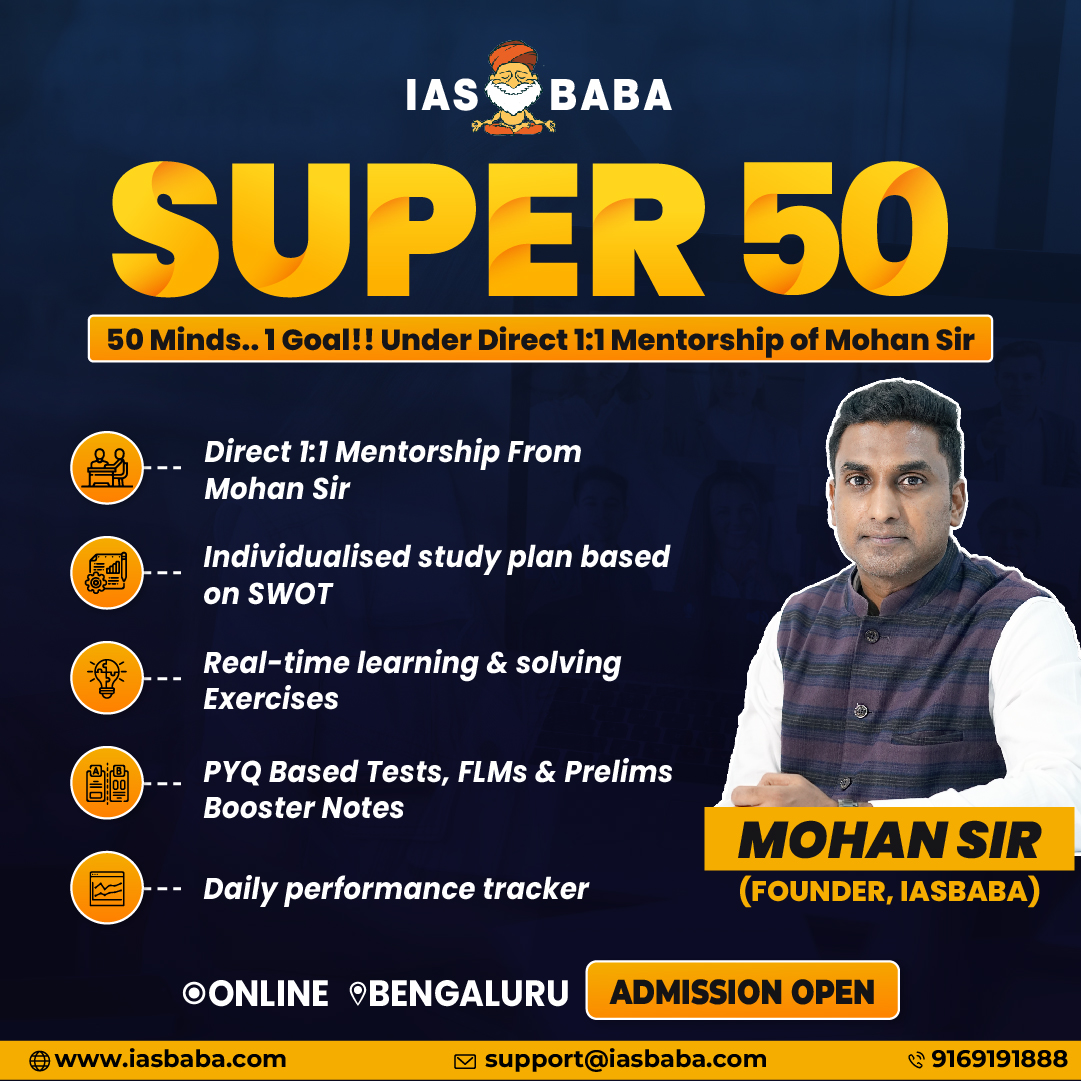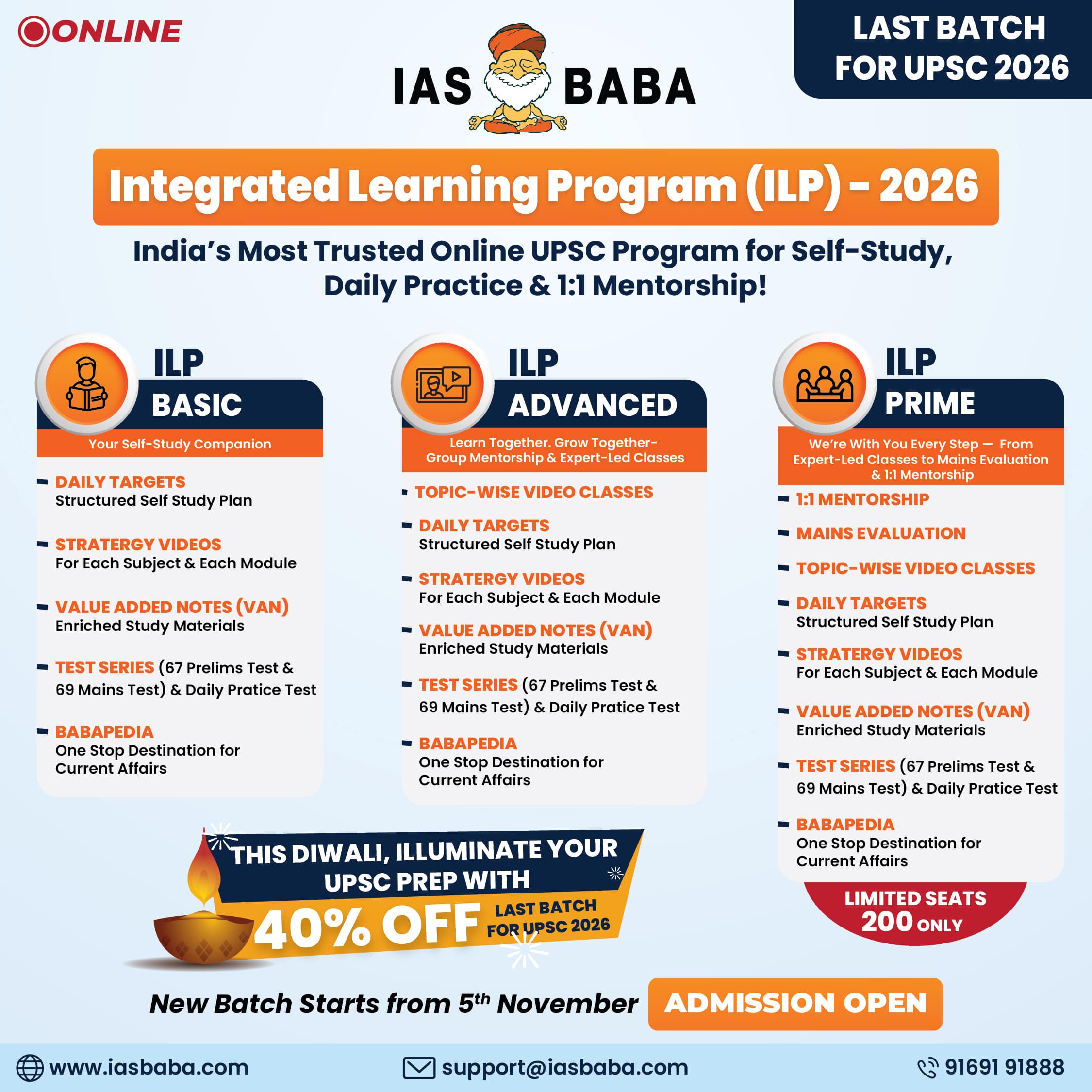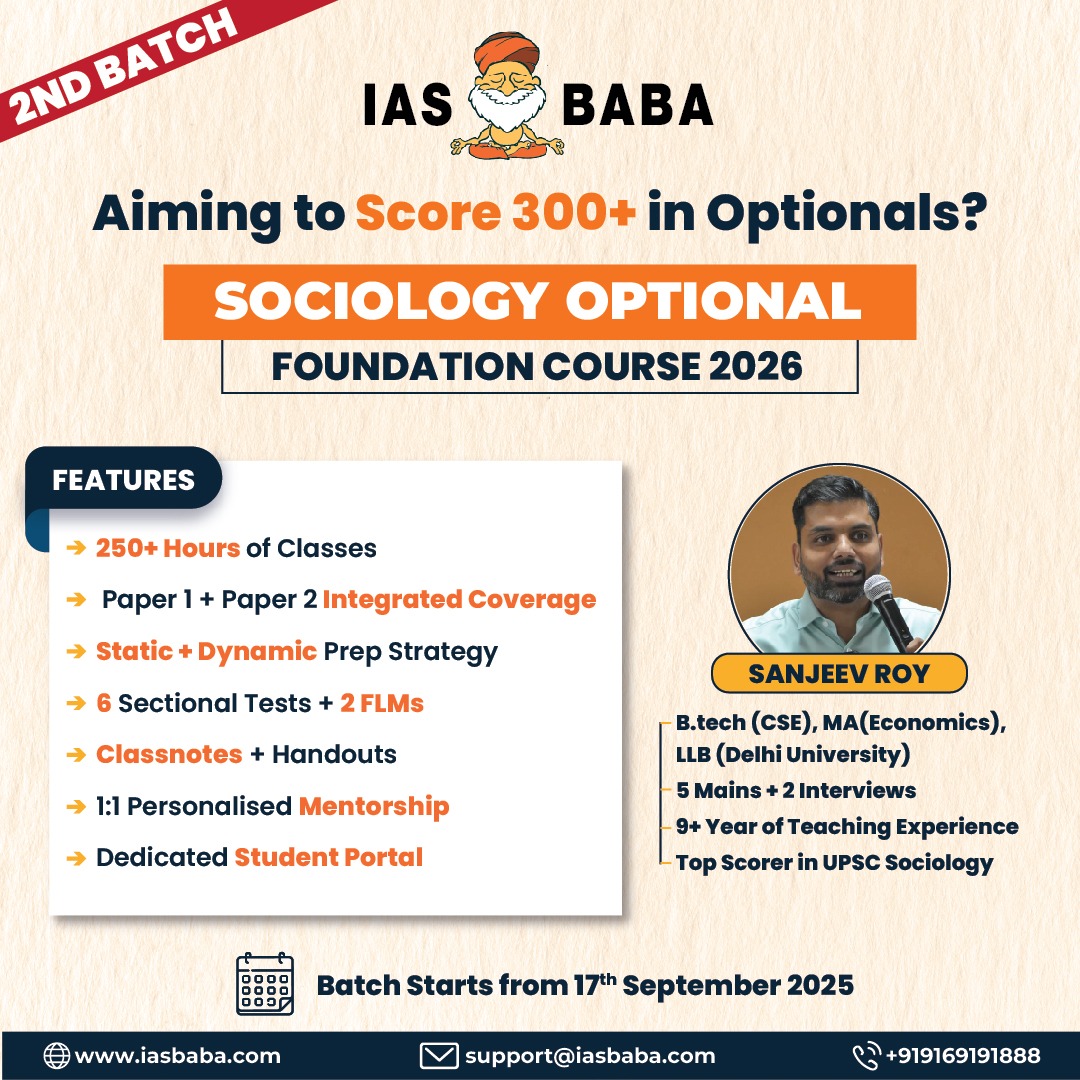IASbaba's Daily Current Affairs Analysis
rchives
(PRELIMS Focus)
Category: DEFENCE
Context: INS Aravali is a newly commissioned shore-based naval information and communication facility of the Indian Navy in Gurugram, Haryana.
Key Highlights
- Nature: Not a warship, but a state-of-the-art naval information base.
- Role: Functions as a headquarters for real-time maritime surveillance, data fusion, and threat detection in the Indian Ocean Region.
- Global Linkages: Connects with 43 multinational centers across 25 countries for live maritime data sharing, aiding cooperation against piracy, terrorism, smuggling, and illegal fishing.
- Symbolism: Named after the resilient Aravali Range; its crest features a mountain and rising sun symbolizing strength and vigilance.
Core Capabilities
- AI-driven surveillance of ships and submarines with rapid threat analysis.
- Satellite-enabled communication through GSAT-7R.
- National Maritime Domain Awareness Center (NMDA) to be housed within, integrating security and intelligence agencies.
- Global maritime hub for India’s international security partnerships.
Source: PIB
Category: ENVIROMNENT
Context : The Indian government is conducting trials to blend isobutanol with diesel fuel after ethanol–diesel blends failed due to engine compatibility issues like corrosion and operational problems.
Why Isobutanol?
- Better Compatibility: A four-carbon alcohol with higher energy density and lower water absorption than ethanol, reducing corrosion risks in diesel engines.
- Ongoing Trials: A 10% isobutanol–diesel blend is being tested for performance, emissions, and efficiency.
- Policy Push: Supports the National Biofuel Policy by reducing oil imports, enhancing energy security, and creating farmer income through biomass demand.
Learning Corner:
National Biofuel Policy, 2018
- Objective: To promote the production and use of biofuels for reducing crude oil imports, ensuring energy security, generating rural income, and promoting cleaner fuels.
- Key Features:
- Types of Biofuels: Categorized as Basic (1G – ethanol from sugarcane juice, molasses, etc.) and Advanced (2G ethanol, drop-in fuels, bio-CNG, bio-hydrogen).
- Feedstock Expansion: Allows production of ethanol from surplus food grains (like maize, damaged grains, rice, etc.) subject to approval.
- Blending Targets:
- Ethanol Blending in Petrol: Achieve 20% (E20) by 2025-26.
- Biodiesel Blending in Diesel: Achieve 5% by 2030.
- Incentives: Viability gap funding, tax incentives, and interest subvention for 2G bio-refineries.
- Waste-to-Wealth: Promotes biofuels from urban, industrial, and agricultural waste to reduce environmental pollution.
- Recent Context:
- E20 blending with petrol has been achieved nationwide.
- Diesel blending with ethanol failed, leading to current trials with isobutanol–diesel blends as an alternative.
- Significance:
Reduces dependence on fossil fuels, improves air quality, supports farmer incomes, and contributes to India’s climate goals under the Paris Agreement.
Source: THE HINDU
Category: HISTORY
Context: On 11 September 2025, Prime Minister Narendra Modi paid tribute to Acharya Vinoba Bhave on his birth anniversary.
Recalling his immense contributions as a spiritual leader, freedom fighter, and social reformer. He highlighted Bhave’s role in popularizing Gandhian ideals, uplifting the marginalized, and inspiring national progress, calling him “one of India’s most revered leaders” whose teachings guide the vision of building a Viksit Bharat.
Learning Corner:
Acharya Vinoba Bhave (1895–1982)
- A renowned spiritual leader, freedom fighter, and social reformer, often regarded as the spiritual successor of Mahatma Gandhi.
- Bhoodan Movement (1951): Initiated the Land Gift Movement, urging landlords to voluntarily donate land to the landless, symbolizing nonviolent social change.
- Association with Gandhi: Deeply influenced by Gandhian philosophy of truth and nonviolence; chosen as the first Individual Satyagrahi (1940) against British rule.
- Advocated Sarvodaya (welfare of all), social equality, rural upliftment, and selfless service.
- Promoted constructive programs like education, rural reform, and community development.
- Awarded the Bharat Ratna (posthumously in 1983), India’s highest civilian honor.
Legacy:
Vinoba Bhave is remembered as the “National Teacher” (Acharya) whose movements and teachings emphasized harmony, compassion, and social justice, leaving a lasting imprint on India’s socio-political landscape.
Source: PIB
Category: ECONOMICS
Context : Provisional CPI release for August 2025.
CPI Data – August 2025 (Base 2012=100)
| Category | CPI Index Number | Inflation Rate (%) |
|---|---|---|
| Rural | 198.7 | 1.69 |
| Urban | 195.0 | 3.07 |
| Combined | 197.0 | 2.07 |
Key Highlights
- All-India CPI inflation for August 2025 stood at 2.07%, up by 46 basis points from July.
- Rural inflation: 1.69% | Urban inflation: 3.07% → higher urban price pressures.
- Food inflation declined: -0.70% (rural) and -0.58% (urban).
- Data collected from over 1180 villages and 1110 urban markets nationwide.
Learning Corner:
The Consumer Price Index (CPI) measures changes in retail prices of goods and services consumed by different groups of people. In India, CPI is compiled and released by the National Statistical Office (NSO), Ministry of Statistics and Programme Implementation (MoSPI).
Major Variants:
- CPI-Rural (CPI-R):
- Measures price changes for the rural population.
- Basket includes food, fuel, clothing, housing, education, health, etc.
- CPI-Urban (CPI-U):
- Measures price changes for the urban population.
- Captures expenditure patterns in cities/towns.
- CPI-Combined (CPI-C):
- A combination of rural and urban indices.
- Used as the headline CPI inflation measure by the Reserve Bank of India (RBI) for monetary policy decisions.
- Special CPIs (historical/older series):
- CPI for Industrial Workers (CPI-IW) → compiled by Labour Bureau, used for wage indexation.
- CPI for Agricultural Labourers (CPI-AL) and CPI for Rural Labourers (CPI-RL) → also compiled by Labour Bureau, mainly for wage/farm worker policy decisions.
Current Relevance:
- Since 2011–12 base revision, CPI-Combined (CPI-C) is the official measure of retail inflation in India.
- Older indices (CPI-IW, CPI-AL, CPI-RL) are still used for specific purposes like wage indexation and policy support for workers.
Source: PIB
Category: INTERNATIONAL
Context: India announced a $680 million special economic package for Mauritius after talks between PM Narendra Modi and Mauritian PM Navin Ramgoolam in Varanasi.
- China’s newest aircraft carrier, Fujian, sailed through the Taiwan Strait for the first time while heading to the South China Sea for training and trials. Beijing described the passage as routine, though it comes amid rising tensions over U.S. and allied naval transits in the strait. Japan also reported spotting the Fujian near disputed waters, escorted by destroyers, highlighting growing regional security concerns. The move reflects both China’s expanding naval power and the strategic sensitivity of the Taiwan Strait.
Learning Corner:
Fujian
- Type: Type 003 aircraft carrier of the People’s Liberation Army Navy (PLAN).
- Launched: June 2022, named after Fujian Province (closest to Taiwan).
- Significance:
- Third Chinese carrier, after Liaoning (Type 001) and Shandong (Type 002).
- First fully indigenously designed and built carrier by China.
- Represents a major leap in Chinese naval modernization.
- Key Features:
- Equipped with Electromagnetic Aircraft Launch System (EMALS) → allows launching heavier aircraft (like advanced fighter jets, surveillance planes, drones).
- Estimated displacement: over 80,000 tonnes.
- Conventional (not nuclear) powered.
- Strategic Context:
- Strengthens China’s power projection in the Taiwan Strait, South China Sea, and Indo-Pacific.
- Seen as a counter to U.S. naval dominance in the region.
- Recently conducted sea trials and sailed through the Taiwan Strait (Sept 2025), heightening regional tensions.
Source: THE HINDU
(MAINS Focus)
Introduction (Context)
International Day of the World’s Indigenous Peoples (August 9) highlighted the continued denial of property rights to tribal women.
Except for certain matrilineal tribes in the North-East, customary laws across tribal communities often exclude women from succession rights.
This raises critical questions of gender justice, equality under the Constitution, and protection of indigenous identity.
Land and equality
- Tribal customary laws govern matters of succession, marriage, and adoption.
- Despite women contributing more in farms than the men, none of the tribal customary laws prevalent in the Scheduled Five Area States (which also includes Chhattisgarh, Jharkhand and Odisha) give land inheritance rights to females in ancestral properties.
- The All India Report on Agriculture Census 2015-16 shows that 16.7% of ST women possess land when compared to ST men (83.3%).
- In tribal society, land is often seen as communitarian property, not something that can belong to an individual
- However, when tribal land is sold or acquired, the money rarely goes to the gram sabha or community, and is instead controlled by individuals.
- A common reason given to deny women land rights is the fear that if tribal women marry non-tribal men, land will pass to outsiders.
- In reality, even if land is transferred, its nature as indigenous or tribal land remains intact, especially in the case of forest land.
- Gender disparity in property ownership translates into economic marginalisation, political invisibility, and social dependency for tribal women.
Judicial Interventions
Ram Charan & Ors. vs Sukhram & Ors. (2025)
-
The case arose in Sarguja district, Chhattisgarh.
- Plaintiff: Legal heirs of Dhaiya, a Scheduled Tribe woman, claimed partition of ancestral property.
- Trial & Appellate courts rejected plea citing Gond custom of male-only inheritance.
- Supreme Court held:
- Denial of property rights under guise of custom perpetuates gender discrimination.
- Female heirs entitled to equal share in property.
Madhu Kishwar vs State of Bihar (1996)
- Raised issue of parity in intestate succession among tribals.
- Court refrained from striking down customs, citing fear of legal chaos.
- Revealed judiciary’s reluctance in directly confronting tribal patriarchy.
Prabha Minz vs Martha Ekka (Jharkhand HC, 2022)
- Court recognised property rights of Oraon tribal women.
- Held that customs excluding women from inheritance must meet tests of antiquity, continuity, reasonableness, and conformity with public policy.
Kamala Neti vs Special Land Acquisition Officer (2022)
- SC upheld tribal women’s rights in compensation related to land acquisition.
Seen as an affirmative step towards gender parity.
Way forward
- Enact a Tribal Succession Act, codifying inheritance rights for women.
- Strike balance between indigenous traditions and constitutional equality.
- Courts must continue to test customs on grounds of reasonableness and public policy.
- Civil society, women’s groups, and tribal leaders must sensitise communities.
- Promote joint land titles in government land distribution.
- Expand access to credit, schemes, and skill-building for tribal women.
- Codification of tribal laws on the lines of Hindus and Christians can also help resolve the issue substantially.
Conclusion
Exclusion of tribal women from property rights is not just a customary practice but a constitutional question of equality. Supreme Court judgments mark a progressive shift, but piecemeal interventions are insufficient. Gender justice for tribal women must be seen as integral to inclusive development and constitutional morality.
Mains Practice Question
Q The denial of land inheritance rights to tribal women perpetuates economic and social inequality.” Discuss. (250 words, 15 marks)
Introduction (Context)
The Right to Information (RTI) Act, 2005 was a landmark legislation that empowered citizens to hold the state accountable by accessing information. It has been one of the strongest tools for ensuring transparency, curbing corruption, and deepening participatory democracy.
However, recent amendments through the Digital Personal Data Protection (DPDP) Act, 2023 have drastically altered Section 8(1)(j) of the RTI Act. This shift, critics argue, effectively transforms RTI into a “Right to Deny Information (RDI)”.
About Right to Information
- The Right to Information (RTI) Act is based on the idea that in a democracy citizens elect their representatives, who then control the bureaucracy, so the information must flow back to the people.
- One important exemption is Section 8(1)(j), which deals with personal information.
- According to the Section, the government could refuse to give information only in two cases:
- If the information had nothing to do with any public work or public activity.
- If giving it would unnecessarily interfere with someone’s personal privacy unless sharing it was clearly in the larger public interest (for example, exposing corruption)
- There was also a strong safeguard: if the government could not refuse that information to Parliament or a State Legislature, then it could not refuse it to an ordinary citizen either.
- Restrictions on RTI must follow Article 19(2) of the Constitution, which limits them only on grounds like decency and morality. If sharing violates decency or morality, it can be denied both to Parliament and to citizens.
(Public work / public activity means any task, function, or duty that the government, a public authority, or a public official performs as part of their job for the people.)
The Amendments under DPDP Act
- The DPDP Act has changed Section 8(1)(j) of the RTI Act, making it very easy to deny information.
- The main problem is the meaning of “personal information,” which is not clearly defined.
- There are two different ways to understand it:
-
- One view is that “person” means only a normal human being (natural person).
- Another view, based on the DPDP Act, says “person” also includes companies, firms, associations, Hindu undivided families, and even the State.
- If the broader DPDP definition is applied, almost everything can be treated as personal information.
- This allows most information to be denied, turning RTI into a “Right to Deny Information (RDI).”
- Such an interpretation goes against the spirit of transparency and accountability.
- The DPDP Act also has a clause that overrides all other laws in case of conflict, making it stronger than RTI.
- It imposes heavy penalties (up to ₹250 crore) for wrong disclosure, creating fear among Public Information Officers (PIOs). Since most records are now digital, PIOs may prefer to reject applications to avoid risk of punishment.
- This may change RTI to Right to Deny Information.
Consequences
- These amendments are harmful for public accountability and the fight against corruption.
- Citizens are the best watchdogs against corruption. If they are denied information, this natural monitoring mechanism is lost.
- With the wider meaning of “personal information”, even basic and important documents can be withheld.
- Example: Sharing details of pension beneficiaries to combat “ghost employees” and “ghost cards” will cease. Even a simple order signed by an official could be denied as “personal information”. It can result in over 90% of information being denied.
- Corruption will find safe cover. Details of ghost employees, fraud in welfare schemes, or charges of misconduct can all be classified as “personal information”, making it easy for corruption to continue without exposure.
- Though the RTI Act still has a clause that allows disclosure if “larger public interest” is served, in practice this is rarely used. Citizens should not have to prove larger public interest to access what is already their fundamental right.
- In reality, less than 1% of decisions apply this “larger public interest” exception. Officers usually avoid it because it is hard to weigh private harm against public benefit. This makes the safeguard almost useless after the amendment.
- RTI is part of the right to freedom of speech and expression under Article 19(1)(a). Restricting it without proportional safeguards is unconstitutional.
Way Forward
- Media and citizens must actively engage through public discussions, debates, and awareness drives to show how the amendment weakens democracy.
- Political parties should be pressured to commit in their manifestos that the amendment will be reversed.
- Civil society groups and RTI activists need to strengthen public opinion by mobilising grassroots campaigns.
- The amendment can be challenged in courts, as its constitutionality can be tested against Articles 19(1)(a) and 21.
- Laws must be balanced so that data protection safeguards individual privacy without becoming a shield for the state to hide information.
Conclusion
The RTI Act transformed governance by making secrecy the exception and disclosure the norm. The DPDP-led amendment to Section 8(1)(j) threatens to reverse this ethos, replacing transparency with opacity. If unchecked, this could cripple one of India’s most powerful democratic tools against corruption and abuse of power.
Mains Practice Question
Q The recent amendment of Section 8(1)(j) of the RTI Act through the DPDP Act has been described as a “fundamental regression” in transparency. Critically examine its implications for democracy, accountability, and the citizen’s right to know. (250 words, 15 marks)














